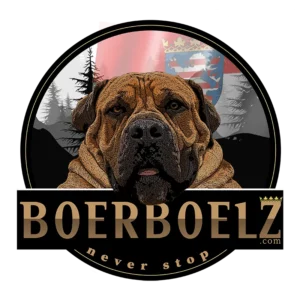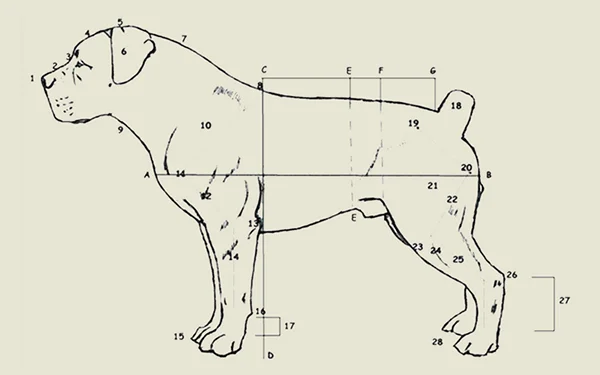BREED STANDARD
 Strength, courage, and steadfastness are the standout qualities of Boerboels. They are muscular and stocky, with a thick neck and big bones. Their size doesn’t weigh them down, however, as they are both powerful and agile in motion. Their dark brown eyes are alert and attentive. When they are inquisitive, their forehead displays slight wrinkling. Boerboels’ V-shaped ears hang forward, and they have deep black coloring on the facial mask, nose, and paws.
Strength, courage, and steadfastness are the standout qualities of Boerboels. They are muscular and stocky, with a thick neck and big bones. Their size doesn’t weigh them down, however, as they are both powerful and agile in motion. Their dark brown eyes are alert and attentive. When they are inquisitive, their forehead displays slight wrinkling. Boerboels’ V-shaped ears hang forward, and they have deep black coloring on the facial mask, nose, and paws.
Boerboels developed when powerful breeds brought to South Africa by Dutch colonists were interbred with indigenous dogs. It is thought Mastiffs, Bulldogs, and Rhodesian Ridgebacks contributed DNA to the modern Boerboel. What emerged was a fearsome, versatile dog who could protect remote farms and withstand South Africa’s heat. Fans of Boerboels began a breeding program in the 1980s to establish today’s purebred standard. Boerboels soon became popular as companion dogs in urban areas of South Africa and gained modest popularity in other parts of the world as well. There is a bunch organisations like: SABBS (SABT), NABBA, BI, BEU and the American Kennel Club.

Body length measured from A (prosternum) – B (rear of the rump/croup)
Body height measured from C (withers) to the ground (D)
Forequarter: A – C
Back: C – E
Loin: E – F
Centre piece C – F
Croup/Rump: F – G (tail setting)
1. Nose leather
2. Nasal bone (muzzle)
3. Stop
4. Cranial roof
5. Plateau
6. Ear
7. Muscular arch on neck
8. Withers (top of scapula)
9. Dewlap
10. Shoulder blade (scapula)
11. Shoulder joint (point of shoulder)
12. Upper front leg (humerus)
13. Elbow
14. Lower front leg (radius and ulna)
15. Front paws
16. Pastern joint
17. Front pastern
18. Tail
19. Ilium (point of hip)
20. Ischium (point of buttock)
21. Primary thigh
22. Femur
23. Knee (stifle)
24. Secondary thigh
25. Tibula and fibula
26. Hock
27. Hind pastern
28. Hind paws